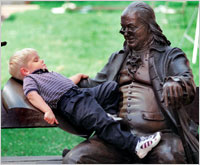Innovation
27 December 2007
Benjamin Franklin Viewed Invention as Form of Public Service
In politics, business, science he embodied America’s spirit of innovation

Washington -- U.S. Founding Fathers George Washington, Thomas Jefferson, Alexander Hamilton and John Adams all made contributions of a practical kind to the nascent American society, but it was Benjamin Franklin who embodied the inventiveness and sheer creative energy that would mark the American character.
Franklin (1706-1790) was a self-made man who rose to international prominence in equal parts as inventor, scientist, revolutionary and statesman. The remarkable course of Franklin’s life, from his humble upbringing as the 10th son of a Puritan soapmaker in Colonial New England to his place as the era’s most celebrated scientist and diplomat, revealed quite a bit about the opportunity and promise for advancement the young American nation offered its enterprising sons (and, a bit later, also its daughters).
A one-time penniless runaway, Franklin strove throughout his life to improve society, including founding the first lending library, a university, the first postal service and a respected scholarly society. He became a devoted citizen of his adopted hometown of Philadelphia, which when he arrived in 1723 was a far larger city than either New York or Boston. Franklin considered his scientific experiments and inventions, including bifocal lenses and a smoke-free wood-burning stove, as a type of public service and he never patented or took money for any of his inventions.
“An inventor is someone who sees the world for what it can be, not what it is now,” says Saul Griffith, a young engineer and inventor who holds a 2007 MacArthur Fellowship for creative entrepreneurs, and Franklin’s life proves that invention really is about change, dissatisfaction with the status quo and a drive to create a better way of doing things.
It was in this spirit that Franklin and his younger colleagues, such as Jefferson, Adams and John Hancock, in the Continental Congress set about inventing a new nation to be led by a representative form of governance in the years preceding the Declaration of Independence from Britain in 1776. Franklin, whose only son was a royalist governor, initially sought a form of autonomous union with the British Empire, but soon he came to recognize that a new nation of free citizens had been born in the American Colonies and only through independence could its destiny be fulfilled.
In drawing up the founding documents, Franklin was inspired by his background in experimentation, invention and the rationality he found in the physical world, according to Walter Isaacson, author of Benjamin Franklin: An American Life. He was instrumental in designing the federal system of government whereby the states would share power with a central authority. But it was his inclusion of the line, “We hold these truths to be self-evident” into Jefferson’s draft of the Declaration of Independence, which referred to the inalienable rights of man, that stamped the United States as a society based on rational examination of reality.
Franklin was a proud member of the “middling classes” and he viewed his inventions and publications as a method to develop and improve the merchant middle class through an embrace of technology and democratic institutions. Thriving on the free flow of information and an unencumbered flow of new ideas both in his own life and in the society around him, Franklin foreshadowed much of what America would become.
Isaacson believes Franklin, who famously flew a kite during a storm to prove the theory that lightning is electricity, would have embraced the technology-laden modern world and he would have made extensive use of the Internet to spread information. “He was a great inventor; he was very technologically advanced. He believed in figuring out business plans or how you could make some new technology work. So I suspect he would be sort of publishing his own Web site; he would be enjoying the new technology. This is why we relate to him,” Isaacson said in an interview with U.S. public television during a celebration of Franklin’s 300th birthday in 2006. (See related article.)
Franklin’s legacy continues today also because he had a knack for combining practicality with fun, which is said to be another “American” trait. He invented swim fins for his feet and hands because he wanted to move faster in the water. He planted the first willow trees in America from an imported basket that had sprouted leaves. He is believed to be the inventor of the glass armonica, a sort of spinning glass organ. He even used his newly discovered method of conducting electricity in an attempt to cook a turkey, but instead gave himself a strong jolt. Remarkably, Franklin also first diagnosed the source of lead poisoning among glass and ceramic artisans, used electro-shock therapy to treat convulsions and correctly determined that dark-colored clothing conducts more heat than light-colored cloth.
Throughout the 19th century, as America expanded, it became a hotbed of innovation as the groundwork of the founders provided an environment for creative thought. A recent Internet survey found that 88 percent of the 262 “Great Inventions” (since 1800) listed by the Encyclopedia Britannica Almanac occurred in democratic societies, despite the fact that the majority of people lived in nondemocratic states during much of this time.
